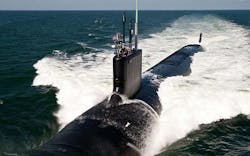Lockheed Martin to build six electro-optical surveillance systems for Navy submarine forces
WASHINGTON, 12 Dec. 2016.Submarine combat systems experts at Lockheed Martin Corp. will build six more electro-opticalsurveillance systems for several classes of Navy fast-attack and ballistic-missile submarines under terms of a $13.2 million order announced Friday.
Officials of the Naval Sea Systems Command (NAVSEA) in Washington are asking the Lockheed Martin Rotary and Mission Systems segment in Manassas, Va., to build six AN/BVY-1 Integrated Submarine Imaging Systems (ISIS) for the Navy's submarine fleet.
ISIS provides mission critical, all-weather, visual, and electronic search, digital image management, indication, warning, and platform architecture interface capabilities for Los Angeles-, Seawolf-, and Virginia-class fast-attack submarines, as well as on Ohio-class ballistic missile and cruise-missile submarines.
ISIS represents a submarine upgrade to integrate all imaging capabilities on existing Navy submarine classes. It is part of the Navy's submarine Photonics Imaging System, a non-hull-penetrating replacement for existing optical periscopes.
The Photonics Imaging System uses a wide portion of the electro-magnetic spectrum with advanced electro-optic/thermal imaging, and communications intercept/electronic warfare support (ES).
Related: EO/IR sensors boost situational awareness
The ISIS program seeks to replace the optical light path of existing submarine periscopes with high-definition cameras and fiber optic digital imagery; use infrared cameras for image enhancements; provide active and passive range finding control; install image enhancement capabilities and analysis tools for real time and recorded imagery; provide image recording, storage, and recall capabilities; and provide the ability to transmit imagery off the submarine to other naval and joint forces.
In-Depth Engineering Corp. in Fairfax, Va., under subcontract to Lockheed Martin, serves as the software development lead for AN/BVY-1 ISIS.
ISIS revolutionizes Navy submarine surveillance capabilities by integrating digital video and still images from devices on a submarine's exterior and presenting real-time imagery and analysis on existing control room tactical displays.
ISIS provides digital image enhancement for data from a modern submarine's photonics mast. The photonics mast uses optical fiber to move imaging data from a raised mast aboard a submerged submarine through tiny openings in the submarine's hull to tactical displays around the interior of the vessel.
Related: Lockheed Martin to upgrade sonar signal processing computers for Navy undersea surveillance
The photonics mast replaces or augments the traditional periscope aboard U.S. submarines. The photonics mast not only replaces the large opening in the submarine pressure hull necessary for the optics and hydraulics of a traditional periscope, but also can blend image data from several kinds of electro-optical sensors aboard the photonics mast, including visible-light and infrared cameras.
The ISIS system enables a submarine operator to manipulate a photonics mast with a joystick, while looking at digital video on a computer monitor, and share that video real-time with the submarine's combat team on various displays aboard the vessel.
On this order Lockheed Martin will do the work in Manassas, Va.; Northampton and Marion, Mass.; and Chantilly, Va., and should be finished by October 2018.
For more information contact Lockheed Martin Rotary and Mission Systems online www.lockheedmartin.com/us/rms.html, or Naval Sea Systems Command at www.navsea.navy.mil.
Learn more: search the Aerospace & Defense Buyer's Guide for companies, new products, press releases, and videos

